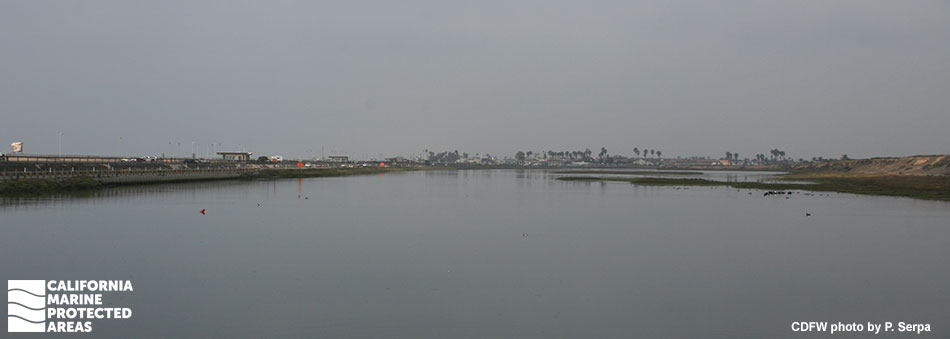
Overview
Bolsa Bay State Marine Conservation Area (SMCA) and Bolsa Chica Basin SMCA (No-Take) are adjacent marine protected areas (MPAs) located along Highway 1 in the city of Huntington Beach in Orange County. Together the MPAs cover nearly one square mile of critical estuary and salt marsh, overlapping a portion of the 1,200-acre Bolsa Chica Wetlands. The wetlands include one of the largest remaining saltwater marshes in Southern California.
Running for nearly two miles parallel to Bolsa Chica State Beach, the wetlands contain two primary habitats: a low-lying intertidal wetland that is frequently inundated by water, and a high marshy area. The tidal flats here provide important nursery habitat for young fish, as well as crabs, shrimp, and other marine invertebrates. Horn snails and crabs are common in the tidal basin. The SMCA provides trails and interpretive signs to help explore the wetlands and observe the local wildlife. Within the MPAs, American white pelicans, northern harriers, and egrets can be seen feeding year-round, and migratory waterfowl and shorebirds proliferate in the winter.
Regulations
Bolsa Bay SMCA
It is unlawful to injure, damage, take, or possess any living, geological, or cultural marine resource, EXCEPT:
Recreational take of finfish by hook-and-line from shore in designated areas is allowed. Entry permitted only on established trails, paths or other designated areas. Closed from 8 p.m. to 6 a.m. Boating, swimming, wading and diving prohibited.
California Code of Regulations Title 14, Section 632(b)(121)(opens in new tab)
Bolsa Chica Basin SMCA (No-Take)
It is unlawful to injure, damage, take, or possess any living, geological, or cultural marine resource. Take incidental to certain permitted activities may be allowed. Other restrictions may apply. See CCR T14 §632(b) for details.
California Code of Regulations Title 14, Section 632(b)(122)(opens in new tab)
Quick Facts
Bolsa Bay SMCA
MPA size: 0.07 square miles
Habitat composition*:
- Rock: 0.07 square miles
- Sand/mud: 0.70 square miles
Bolsa Chica Basin SMCA (No-Take)
MPA size: 0.70 square miles
Habitat composition*:
- Estuary: 0.65 square miles
- Eelgrass: 0.05 square miles
- Coastal marsh: 2.95 square miles
*Habitat calculations are based on three-dimensional area and may exceed the total MPA area listed above.